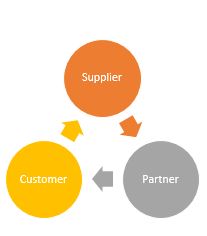Each year Phase 3 publish our predictions for the year ahead for the People Technology Sector. Technology attracts interest, it moves fast and it’s seen as a sign of the times. HR and people technologies are one way to showcase that your organisation is “with it” and up-to-date. Our ‘Technology Trends’ here shares our views on what might be happening in the year ahead.
1: Partnering will still be the word of the moment
We often refer to the ‘Eco-System’ of the HR and Payroll systems market, and an emerging trend is the move for more suppliers to recognise the value ‘Eco-System’ in place. In terms of the HR and Payroll services market we see a 3 ‘legged stool’ approach to servicing customer needs:

This model adds value to the supplier and the customer, ensuring the supplier can focus on product development and sales, and the customer receives a first class experience from a team of professionals who are dedicated to implementation and ongoing support projects day in, day out.
In a wider sense, our expectations as customers of systems now includes integration with other products. Some suppliers lag behind the curve on this, I of course refer to the ‘black box’ HR and payroll systems, whilst others have open API and welcome other providers to integrate into their products to offer customers functionality which they cannot achieve or do not excel in.
“Suppliers are becoming more realistic in what their products can achieve and what they need to outsource to a partner”.
2. Continuance of Consumerisation
Consumerisation of your HR systems means providing a user experience that matches expectations. Those expectations are based on our individual experiences of technology outside of the workplace. How frustrating if getting something done at your desk involves archaic paper or spreadsheet process or endless phone waits if we’re used to a shopping/banking/booking experience via no more than 3 clicks or a bot?!
Artificial Intelligence, Chat-bots and gamification are all to become more commonplace in the People technology space – and as websites in general offer web chat features our expectations for HR systems to allow live chat and bots to assist employees with everyday queries such as ‘What is my annual leave entitlement’ or ‘how much am I being paid this month’.
Whilst there are examples of those who lead the way on web chat and artificial intelligence product roadmaps do not yet show this as a key feature in development – we expect this will change over the course of 2020.
3. HR and Recruitment are getting divorced
Has anyone else been noticing this? From the ‘good old days’ of the Ulrich Model many of those centres of excellence are now moving outside of HR. Learning moved to Organisational Development in many organisations and now recruitment (or ‘Talent Acquisition’) seems to be moving away from HR too. Recruitment teams and functions are sourcing ATS products which service them predominantly and need this to integrate with the HR product. Whilst this adds complexity in terms of integration (and we see too many clients who do not have this integration in place) open integration is becoming more commonplace. We expect ATS system selection to be high on the agenda for many organisations – including features such as job matching, chat bots and online interview arrangements as well as total control over onboarding being the minimum expectation.
4. HR Technology is emerging as a career focus
We’ve thought this for a while but there does seem to be an increased gravitas now for the HR technology professional. Searching for jobs is still cumbersome: HR Systems Manager, HR Business Analyst, HR System Administrator, HR Systems Business Partner are common examples. HR application support has previously been split somewhat between IT and the HR and even payroll functions, often a part of a day job for the HR team. What we are seeing is an emerging trend in that organisations are relying more on technology and therefore the support of that technology is business critical. The benefits of having those in HR with the understanding of the business context developing skills in systems means that the HR service is served by those who fully understand its purpose.
We developed the HR Technology Competency Indicator to enable those working in HR teams to assess their technological competency and our site advertises job vacancies specifically for People Technology vacancies.
5. Users will expect to ‘Checkout online’ for HR and Payroll products and switch quickly
More of a consumer trend here but gone are the days of submitting requests for proposals from smaller system vendors. Many products aimed at those in the small to medium size are starting to offer checkout on the site.
Customers can agree to adopt the product, enter their employee details via upload and then checkout based on the number of people in the system and pay online. This concept may seem alien to some who still rely on the SAAS model and invoice quarterly in arrears for the product and charge lots of extra fees for implementation.
The self serve nature of purchasing the technology we wish to self serve on is becoming more common and we feel some suppliers will lose out if they do not offer this immediate transaction opportunity.
6. Prices will drop – and so will ‘light versions’ of Tier 1 systems
We’ve already started to see the HR and Payroll technology market become more competitive in price and most products price range in the mid tier market are approximately the same – but with much variance in functionality and features offered.
An interesting development is the emergence of tier 1 systems in the mid tier market offering. Traditionally a tier 1 system such as Workday or Success Factors would be out of reach for a mid tier organisation with only 1000 employees. ‘Light’ versions of tier 1 products with agile implementation are appearing and therefore becoming more accessible for the wider audience, with a reduced price and easy adoption these become real contenders when comparing to the big 5 in the mid tier market.
7. Conversations about Pay on Demand for the Gig Economy will continue
This is something I am not 100% comfortable with, I did a survey in our internal team and almost all said this isn’t a feature they would look for. For some roles (in particular ‘gig’ workers) I can see the value in being able to draw down my pay more frequently based on when it has been earned rather than waiting for a static (and somewhat arbitrary) day in the month to receive my payment. My concern is that offering this in a wider sense could result in employees effectively taking interest free payday loans, an emergency results in needing salary earlier but then when I get the balance at the end of the month it isn’t enough to cover essential bills.
The functionality is already available in many products and I would expect this to continue, and with the developments of Faster Payments meaning salaries could potentially be paid and calculated within one day this ‘pay on demand’ could be the future of payroll.
8. Off Payroll Working – Not just for the public sector
Ok so this is less of a prediction around the technology but we are all painfully aware of off payroll working rules.
Before 6 April 2020
If you’re a worker and your client is in the public sector, it’s their responsibility to decide your employment status. You should be told of their decision.
If you are a worker and your client is in the private sector, it’s your intermediary’s responsibility to decide your own employment status for each contract. The private sector includes third sector organisations, such as some charities.
From 6 April 2020
From 6 April 2020 how the rules are applied will change.
All public sector authorities and medium and large-sized private sector clients will be responsible for deciding if the rules apply.
If a worker provides services to a small client in the private sector, the worker’s intermediary will remain responsible for deciding the worker’s employment status and if the rules apply.
The prediction for technology is that we will see through onboarding the ability for workers or employees to determine their own status, and for organisations to use the same tool to assess the employment status of potential employees. The HMRC tool is available (but there are arguments over its accuracy) so to see a product developed to incorporate into the master HR and Payroll database is one which would be welcome!
9. HR Teams will not Shrink in Size
We have lots of conversations with HR and Payroll teams about technology adoption and whilst it might be more true in the public sector that technology adoption has to be offset by reduction in FTE through efficiency research from PwC towards the end of 2017 suggested that more than two thirds of organisations investing in HR systems see no appreciable difference to the size of their HR teams as a result of implementing Cloud HR.
The role of HR is shifting from being the administrators of the organisations payroll and establishment. Business leaders and managers are becoming more empowered to manage their own teams through technology and this information is an important aspect of HR technology (which is purchased for an organisation and not an HR Team). HR teams are therefore supporting more value adding activity and are a strategic resource and organisational partners rather than police. Is the role of the HR generalist secure?
10. Payroll will be outsourced – more than ever
Similarly to the separation of HR and Learning, Payroll is becoming a more distant relative in many organisations. Earlier in the year, we wrote about the best ‘fit’ for payroll – is it with HR or Finance? We predict that Payroll will continue to emerge as a strategic business function in its own right, particularly given the breadth of the payroll teams focus.
The review of where the best fit is should inevitably result in an options appraisal type review of where payroll fits – and whether the best fit it actually external to the business.
We aren’t saying that outsourcing is the right choice in all cases but as a standalone function, it is one of many services which can be lifted and shifted to an outsourced provider.
Phase 3 are the people behind people technology – we support clients with all things people technology through our Consulting, Services and Insights.



